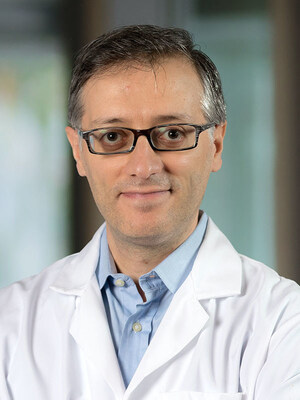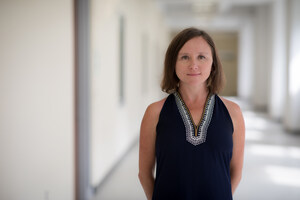BRONX, N.Y., Aug. 28, 2013 /PRNewswire-USNewswire/ -- Scientists at Albert Einstein College of Medicine of Yeshiva University have shown that high-functioning autism spectrum disorder (ASD) children appear to outgrow a critical social communication disability. Younger children with ASD have trouble integrating the auditory and visual cues associated with speech, but the researchers found that the problem clears up in adolescence. The study was published today in the online edition of the journal Cerebral Cortex.
Video: Dr. Foxe explains the findings of his study
(Logo: http://photos.prnewswire.com/prnh/20120531/DC16559LOGO)
"This is an extremely hopeful finding," said lead author John Foxe, Ph.D., professor of pediatrics and in the Dominick P. Purpura Department of Neuroscience, as well as director of research of the Children's Evaluation and Rehabilitation Center at Einstein. "It suggests that the neurophysiological circuits for speech in these children aren't fundamentally broken and that we might be able to do something to help them recover sooner."
According to Dr. Foxe, the ability to integrate "heard" and "seen" speech signals is crucial to effective communication. "Children who don't appropriately develop this capacity have trouble navigating educational and social settings," he said.
In a previous study, Dr. Foxe and his colleagues demonstrated that children with ASD integrate multisensory information such as sound, touch and vision differently from typically developing children. Among typically developing children, multisensory integration (MSI) abilities were known to continue improving late into childhood. The current study looked at whether one aspect of MSI — integrating audio and visual speech signals —continues to develop in high-functioning children with ASD as well.
In the study, 222 children ages 5 to 17, including both typically developing children and high-functioning children with ASD, were tested for how well they could understand speech with increasing levels of background noise. In one test, the researchers played audio recordings of simple words. In a second test, the researchers played a video of the speaker articulating the words, but no audio. A third test presented the children with both the audio and video recordings.
Video: Dr. Foxe describes and demonstrates his research techniques
The test mimics the so-called "cocktail party" effect: a noisy environment with many different people talking. In such settings, people naturally rely on both auditory and facial clues to understand what another person is saying. "You get a surprisingly big boost out of lip-reading, compared with hearing alone," said Dr. Foxe. "It's an integrative process."
In the first test (audio alone), the children with ASD performed almost as well as typically developing children across all age groups and all background noise levels. In the second test (video alone), the children with ASD performed significantly worse than the typically developing children across all age groups and all background noise levels. "But the typically developing children didn't perform very well, either," said Dr. Foxe. "Most people are fairly terrible at lip-reading."
In the third test (audio and video), the younger children with ASD, ages 6 to 12, performed much worse than the typically developing children of the same age, particularly at higher levels of background noise. However, among the older children, there was no difference in performance between the typically developing and children with ASD.
"In adolescence, something amazing happens and the kids with ASD begin to perform like the typically developing kids," said Dr. Foxe. "At this point, we can't explain why. It may be a function of a physiological change in their brain or of interventions they've received, or both. That is something we need to explore."
The researchers acknowledge some limitations to their study. "Instead of doing a cross-sectional study like this, where we tested children at various ages, we would prefer to do a longitudinal study that would involve the same kids who'd be followed over the years from childhood through adolescence," Dr. Foxe said. "We also need to find a way to study what is happening with low- and mid-functioning children with ASD. They are much less tolerant of testing and thus harder to study."
According to the researchers, the work highlights the need to develop more effective therapies to help ASD children better integrate audio and visual speech signals. "We are beginning to work on that," said Dr. Foxe.
The paper is titled "Severe Multisensory Speech Integration Deficits in High-Functioning School-Aged Children with an Autism Spectrum Disorder (ASD) and their Resolution during Early Adolescence." Other Einstein contributors are Sophie Molholm, Ph.D., Victor Del Bene, Daniella Blanco, Hans-Peter Frey and Lars Ross, Ph.D. Additional coauthors are Natalie Russo, Ph.D., at Syracuse University (Syracuse, NY) and Dave Saint-Amour at Université du Québec à Montréal (Montreal, Canada).
This study was primarily supported by a grant from the National Institute of Mental Health (MH085322), part of the National Institutes of Health. Pilot support was provided by Cure Autism Now, the Wallace Research Foundation, Fondation du Quebec de Recherche sur la Societe et la Culture, and the Canadian Institute of Health Research.
About Albert Einstein College of Medicine of Yeshiva University
Albert Einstein College of Medicine of Yeshiva University is one of the nation's premier centers for research, medical education and clinical investigation. During the 2012-2013 academic year, Einstein is home to 742 M.D. students, 245 Ph.D. students, 116 students in the combined M.D./Ph.D. program, and 360 postdoctoral research fellows. The College of Medicine has more than 2,000 full-time faculty members located on the main campus and at its clinical affiliates. In 2012, Einstein received over $160 million in awards from the NIH. This includes the funding of major research centers at Einstein in diabetes, cancer, liver disease, and AIDS. Other areas where the College of Medicine is concentrating its efforts include developmental brain research, neuroscience, cardiac disease, and initiatives to reduce and eliminate ethnic and racial health disparities. Its partnership with Montefiore Medical Center, the University Hospital and academic medical center for Einstein, advances clinical and translational research to accelerate the pace at which new discoveries become the treatments and therapies that benefit patients. Through its extensive affiliation network involving Montefiore, Jacobi Medical Center–Einstein's founding hospital, and five other hospital systems in the Bronx, Manhattan, Long Island and Brooklyn, Einstein runs one of the largest residency and fellowship training programs in the medical and dental professions in the United States. For more information, please visit www.einstein.yu.edu, read our blog, follow us on Twitter, like us on Facebook, and view us on YouTube.
SOURCE Albert Einstein College of Medicine
WANT YOUR COMPANY'S NEWS FEATURED ON PRNEWSWIRE.COM?
Newsrooms &
Influencers
Digital Media
Outlets
Journalists
Opted In





Share this article